Tales from Brazil – Birding at Trilha dos Tucanos
- vidyashok
- Sep 7, 2019
- 12 min read
‘ So, where is your next trip ?”
“ Brazil.”
“ Oh wow !! The Amazon ?”
“ No, to the Pantanal.”
“ Huh ? The Pantanal ? What is that ? “
A couple of years back, that would have been me asking the questions and not have heard of the Pantanal.
Amazon, yes, most definitely. Pantanal ? What is that ?
Pantanal is what National Geographic once called, “ Brazil’s best kept secret’.
It is the world’s largest wetlands covering an area of 210,000 sq kms , spilling over into Bolivia and Paraguay and has the highest concentration of wildlife in the continent.
The Amazon draws all the attention, all the glamour but when it comes to viewing wildlife, Pantanal definitely rules. The Amazon is just too dense for good viewing while Pantanal displays its wares rather selflessly. The photos that I have seen of people who have been to Pantanal…simply fabulous. Those colourful birds, those strange looking animals, and then of course, the jaguar have always made it look like an exotic, sometime-must-visit place.
And so, when I got a call from a friend, asking me if I would be keen to go on a trip to Brazil that was being planned, the answer was a rather easy one.
*****
It was not a trip that took us only to Pantanal. Planned in a really wonderful manner to allow us a taste of as many different experiences as possible ( Praveen Siddanavar- https://www.facebook.com/PraveenSiddannavarPhotography/ – had planned the entire trip ), our first stop was to spend a few days at the Atlantic rainforest before making our way to Pantanal.
To be honest, I wasn’t really aware of all the different ecosystems that existed in South America and what I read ( and I usually read a bit in preparation ) about the Atlantic rainforest was mouthwatering !
It is considered to be second after the Amazon lowlands in terms of biodiversity
It is estimated that only 10% of the original forests still remain
Around 2200 species of land vertebrates live there – roughly 7% of the world !
250+ amphibians, 200+ bird species, 150+ mammals are endemic to the Atlantic rainforest
Phew.
That’s quite some riches.
*****
Trilha dos Tucanos.
Just say it again. It rolls off the tongue in such a lovely, musical way.
Trilha dos Tucanos. Trail of the Toucans.
That’s what the name means. Of course, my experiences with these famed toucans is another story altogether, but let me not digress.

Birds Paradise is definitely the right descriptor !!
Trilha dos Tucanos is a small quaint birding lodge in Tapirai, about a 3 hour road trip from Sao Paulo. It is run by a couple and since our stay there covered the weekend, their two kids were also present lending a helping hand. Actually, it ended up being more than a helping hand since the daughter could speak flawless English which no one else could, and that definitely helped.
Our vehicle eased down the not so gentle slope leading to the lodge and as we got off and stretched ourselves we could see a couple of other guests with their tripods and lens’ busy taking pictures of a rather large number of colourful, tiny yet quite voluble birds just a few feet from them.
What a way to arrive. Action right from the start.
*****
Where do I start about the birds ?
They were simply everywhere. Lovely little birds, showing off such brilliantly vivid colours, flitting all over the place. Birds, the type of which I hadn’t seen before, of sizes and shapes so different from what we normally see elsewhere.
I learnt about the existence of tanagers. We kept seeing them everywhere. All the time. There are simply too many of them not to be everywhere !!
Green-headed Tanager, Golden-chevroned Tanager, Ruby-crowned Tanager, Black-headed Tanager, Olive-green Tanager, Rufous-bellied Thrush, Palm Tanager, Azure shouldered Tanager, Magpie Tanager …how many types of Tanagers exist ??
And then there were the vividly colourful woodpeckers.

The Green headed Tanager is such a cute little bird…very commonly seen and just so pretty

The Green headed Tanagers were everywhere…all the time

The Golden Chevron Tanager looks like a well behaved elegant gentleman here

The Azure Shouldered Tanager…I found them to be such dainty birds

The Yellow Fronted Woodpecker, a vibrantly coloured bird with a delightful call, with the early morning light behind it

The yellow fronted wood pecker again

The Black Goggled Tanager…phew, how many Tanagers…really ?

A Ruby crowned tanager…the male has that distinct red patch which is not easily visible and here, our man obligingly bows his head for us to gawk at it

The Blonde Crested Woodpecker is one zany looking bird tho he looks distinctly Trumpian ( which is a rather cruel thing to say )

Doesn’t he look like one of those Spy vs Spy characters ?

The Magpie Tanager ( what, you thought, that was the end of the tanager family ? )…amongst the larger tanagers
And, of course, many others.
Plain Parakeets, Maroon-bellied Parakeets, Black-throated Grosbeaks, the Tinamou, Uniform Flycatchers, Golden Coloured Warblers, Rufus bellied Thrushes ….phew ! Such variety ! And of such different sizes and colours.

A Plain Parakeet…these guys rarely sit still, with the result that you get some wonderful angles
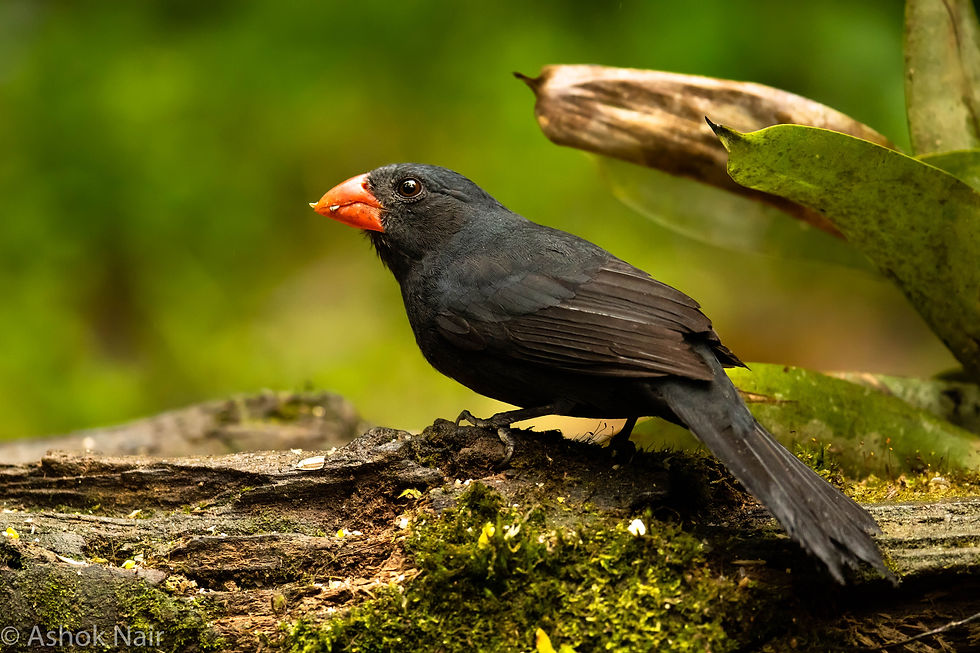
A Black throated Grosbeak…look at that red beak !! By the way, apparently they also are from the tanager family 🙂 🙂
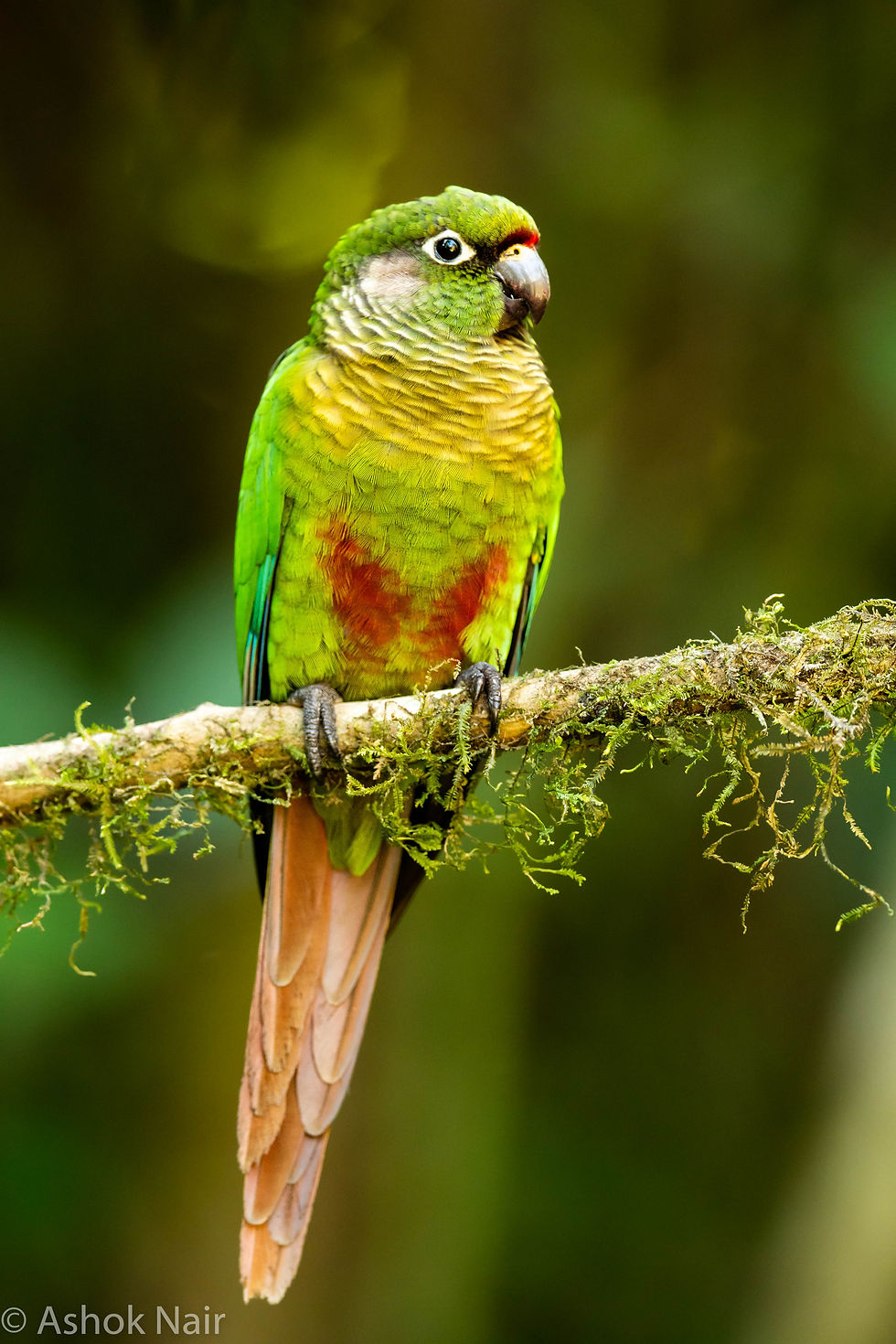
A Maroon bellied parakeet…look at those colours !!

A Plain Parakeet steps closer to explore

The Blue Dacnis with that sinister looking eye wear

The Chestnut bellied Euphonia ( which I think is a lovely name in itself ) is an incredibly beautiful but rather shy bird. Sadly I missed out on getting a clear shot of it on a perch

And this tiny lil thing is the Bananaquit.

The Violaceous Euphonia …I wonder who gave that name…Violaceous

A Red rumped Cacique peers down at something interesting
And I haven’t yet come to the hummingbirds.
Or the toucans.
Or the toucanets.
By a rough estimate we would have seen at least 30 different types of birds ! 30 !!!
And, as if this embarrassment of riches wasn’t enough, we were blessed with some awesome weather over the first two days. A little rain, followed by mild sunshine which gave the most wonderful light for photography. And the slightly damp, cold weather also brought in the birds by the dozen to the feeders.
Ultimate bliss.
*****
“ How right is it to have feeders ? Would it not rob the birds of their natural ability to forage for food ?”
This is a point often made by those who are not comfortable with the concept of feeders and I posed this question to Supreet, from Tropical Tours who had organized this leg of our trip.
His answer was quite emphatic.
“ Its usually bananas that are placed here. Bananas are not their favorite food. If other food is easily available in the forests they won’t bother to turn up here, which is the case in summers, when the lodge too shuts down. In winters, its not so easy to find food in the forest and they turn up here. Its easier for them, their energy is conserved but if food is available in the forests that is where they will go”
Well, its always a bit of a debatable issue but the very next day turned out to be quite a hot one and ….the bird attendance at the feeders was quite disappointing.
So…
*****
The still damp grass crunched softly under our feet, sunlight filtered through the leaves above us and a narrow path lay ahead.
On the day when it was quite sunny and hot and the birds, we decided to leave the feeders and go for a walk around the sprawling premises. Good we did that. It was such a beautiful walk.

‘The woods are lovely, dark and deep….”
There was a decent sized pond on one side and we went around it, down a narrow path with lightly dense foliage around it. A small stream ran parallel to this path till we reached a lovely little bridge over it.

For some weird reason…I love bridges. Right from the scarier ones you see on your Himalayan treks to these quaint and far less riskier ones
It was a quiet walk. You could hear the distant chirping of the birds around you but not many popped into view. It had the quiet that woods tend to usually have. Occasionally you could see a kingfisher fly past. If you waited by the pond, you would see birds swoop down to nab a fish or other food. I sat down and enjoyed the shade, watching a few birds stay focused on the waters for any sight of what could be a good meal and occasionally conducting a raid.
A little further away, was the hide. A perfect place to sit and watch birds come along completely unaware that behind that camouflaged cover, sat strange beings armed with strange objects. Many of the birds that came here weren’t the ones that came to the feeders so that was an added incentive.
We saw the cutely bulbous tinamou, doves, thrushes…the Uniform flycatcher came up quite often and so did the quail ( which I missed 😦 ).

Presenting….the Brown Tinamou !

A Ruby Crowned Tanager, the female which has a rather rich colour

The Half Collared sparrow hops around…those dual coloured beaks really fascinated me !

The Uniform finch made a late and a brief appearance too
Later in the day, Sergio from Tropical Tours, in the middle of a conversation, remarked that he never went for a walk around the place without wearing his boots, cos of the large number of snakes that live there.
Gulp.
Some of us were, shall we say, a lot more relaxed in the footwear we wore !
*****
There was a sudden whirring sound next to my ears as I stood looking intently at some of the recent pictures in the camera.
And I ignored it.
I knew it was a hummingbird.
Beat that. I had a hummingbird humming into my ears and I was shrugging it off !
They are interesting little birds and there were a lot of them around. Quite friendly and comfortable with humans, they would easily come upto you for a sip if you are holding their favourite potion.
There are some really interesting facts about hummingbirds…actually there are lots of interesting facts, but let me just pick on a few top ones :
Hummingbirds are called so cos of the humming sound they make. This sound is of the wings flapping
Their wings flap at an incredible speed…can go to almost 200 times a second ! That’s what allows them to be stationary in the air while feeding from the flowers
Talking of feeding…lets see how these guys drink. When their beaks touch the flower, its their tongue that licks the nectar off the surface. Hang on…their tongues dart in and out of their mouths 13 times a second !
They are incredibly light – most weigh less than a nickel and on an average are 3-6 inches long
They are the only birds that can fly backwards !
And many more….These are incredibly beautiful birds and of course, the main objective for us would always be to take a picture of them in action. And get their wings razor sharp in your picture.
Well…the bad news is that, that’s not possible. You cannot get razor sharp, noise free images of their wings by just playing around with your camera settings cos of the speed at which their wings flap.
That’s when someone came across the bright idea of using a mutli flash setting. Its too complicated to explain ( in other words, I haven’t understood myself 🙂 ) but to put it simply, about 4-7 flashes are positioned around the flowers where you expect the hummingbird to come. These flashes, positioned right, will provide that millisecond of light to illuminate the bird completely. In this case, its not the shutter speed that freezes the wings ( it cannot ) but the light that captures the frozen image.
The camera settings are within a small range. And you just go click click click and you if it syncs with the flash light perfectly, you get a darned sharp image.
But I don’t enjoy it. There is no skill involved especially if someone else is setting up the multi flash arrangement for you. So, while I am posting a few images from that setting below…I get no kicks out of it.

Even if I don’t like this much…must say that you get some real sharp pics…

…and some cute poses

Paying homage before a meal ?

But I did get a decent image through my camera settings :). This nice little one was descending on one of the flowers, the light was bright, I could go to a very high shutter speed without generating noise and most importantly, since it was just about to land, the wings were not flapping as fast.
Here goes :

Not razor sharp, those wings…but not too bad
*****
While it was the birds that always demanded our time and attention, there was one animal that caught our fancy – the tayra. Had never heard of it before but what an interesting animal it is.
Sergio walked in to announce that we need to move out to the front since he had seen a tayra poking its head out of the bushes
Soon it came. Dark, larger than a mongoose, belonging to the weasel family, with one crooked tooth jutting out from the side. It was incredibly shy and cautious. It would poke its head to see if the coast was clear and invariably run away, dart back in a minute later, to grab some of the stuff placed on the ground and then vanish into the undergrowth again.

The tayra comes a little bravely forward…
Slowly, the lure of food got the better of its caution and the tayra advanced further into open patch, eyeing the stuff that was there on the ground and once climbed up a log looking for some titbits. The tayra initially stood up on its hind legs to reach out to the food but a little later clambered up the fallen log eating everything along the way. Of course, in between all this, it would suddenly vanish before making another cautious entry.

But is extremely cautious about what lies around him and easily alarmed into scampering back into the forest…loved that crooked tooth
On other occasions too, it would suddenly dart in to where we all are taking photographs and vanish with something captured in its mouth ! All in all, good fun both to see such an interesting animal and to observe its behavior.
*****
The bird that we were really looking forward to see, however was the toucanet and even more than that, the toucan.
The saffron toucanets put in a visit on the first day itself. A real odd shaped entity. With a prominent beak, a fairly funky head with prominently displayed eyes, it was an immediate hit and thankfully were both in a generous and patient mood.
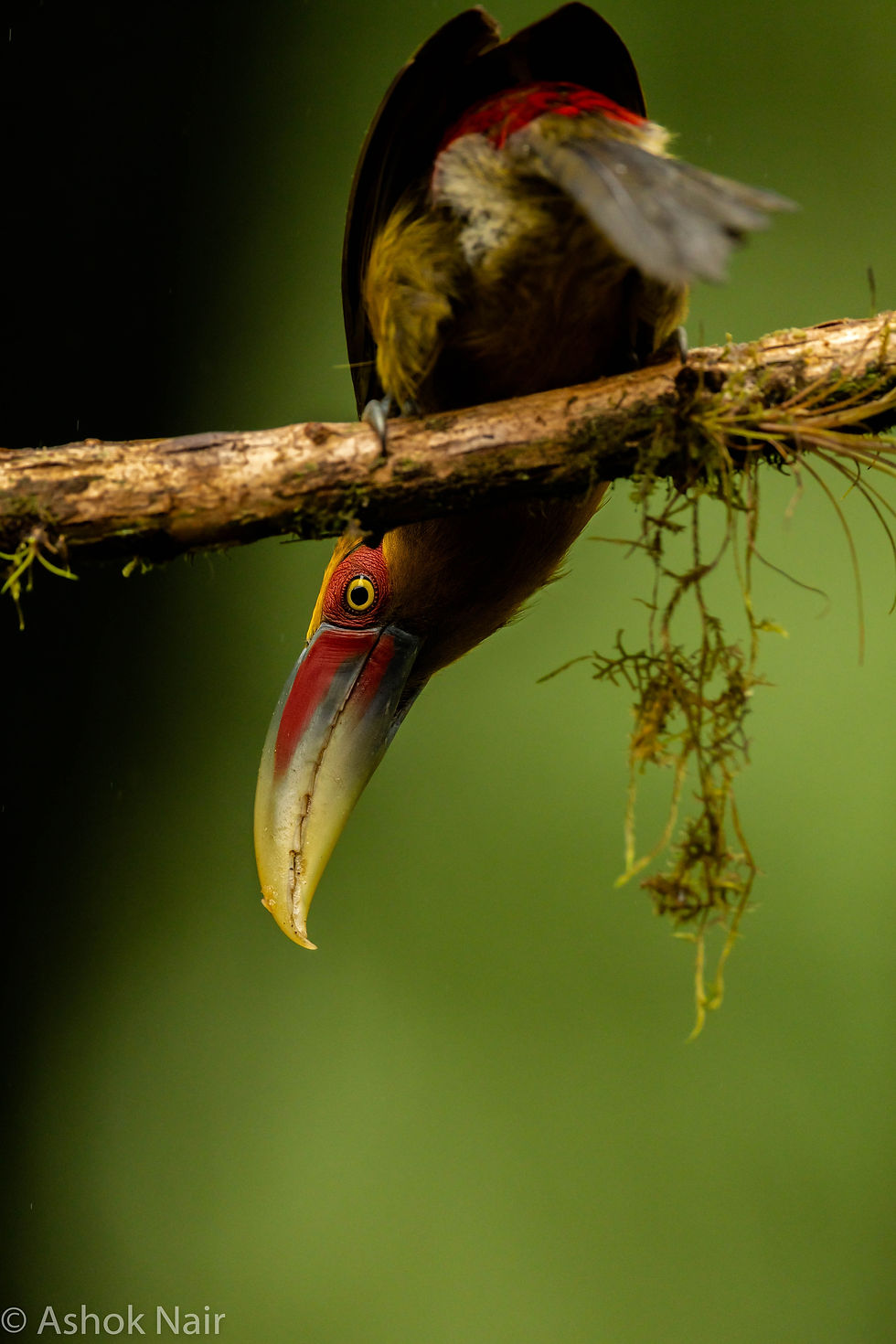
The Saffron Toucanet…love this shot, how the beak and the eyes get the prominence

It does have a rather funky little head…ok, maybe not so little
They stayed at one of the feeders for a very long time allowing us to take as many pics as we wanted. And allowed me to try out some rimlit photography too. Good fun.

I stumbled on this actually…overlooked changing my settings as I rushed to the rear from the far more well lit front, saw that I had underexposed a lot but the image gave me the idea that I could go for rimlit ones and…yes, looks rather cool
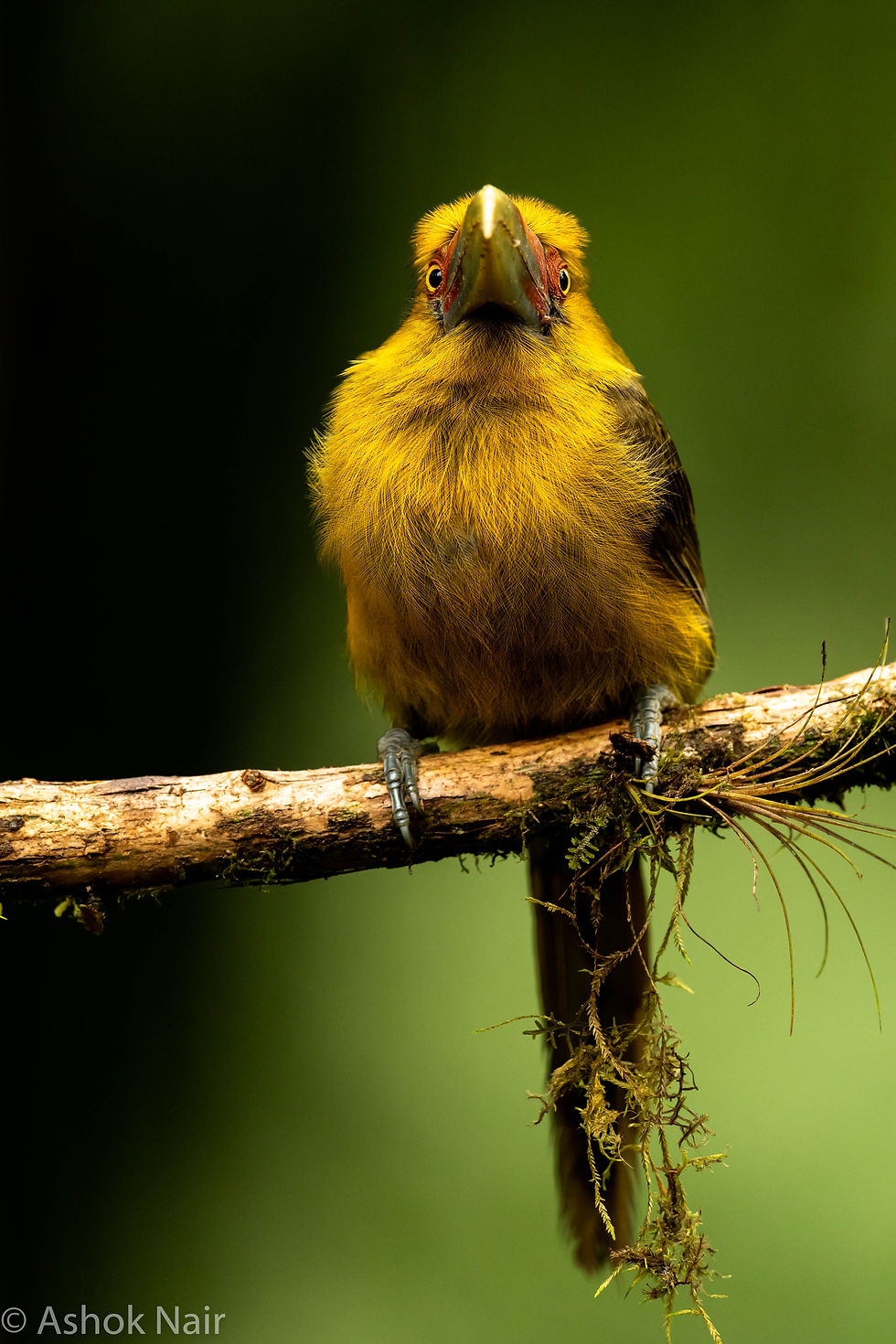
And when these birds look straight at you…they do present an arresting image
Then there were the toucans. But, as I said, I shall save that for another time.
*****
The last day arrived and with it the mists. We woke up to a continuous drizzle and a very misty morning. The entire place looked absolutely surreal in its beauty.

It rained almost continuously and the light didn’t make it very ideal for photography but you can get some excellent pictures in the rain should the light improve a little bit. It did occasionally.

Rains, however, give you some beautiful images…here a maroon bellied parakeet looks like a whiskered old English gentleman from the 18th century ( go ahead, zoom in and see )
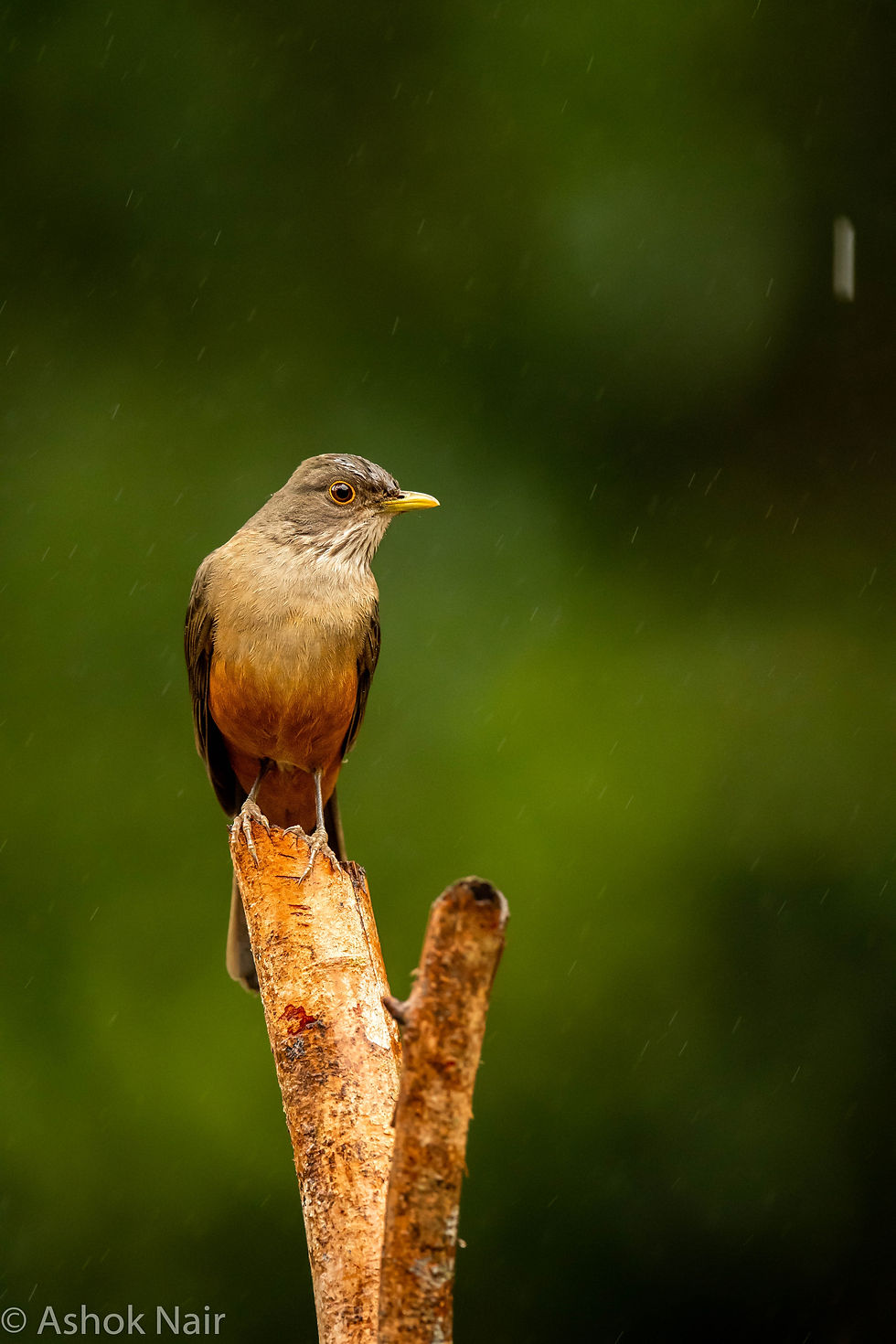
The Rufus bellied Thrush…also Brazil’s national bird

Whhirrrrrr…an Azure shouldered tanager shakes off the water
*****
Trilha dos Tucanos.
A lovely place indeed. The rooms are a little separated from the main lodge. Clean though compact and basic but since we generally come into the rooms only to sleep at night it was perfectly sufficient.
Food was quite good. With more vegetarians in the group we were prepared for some challenges but each meal was a good one and we really didn’t have to struggle or take any of the ready-to-eat packets that we had got with us.
The couple that run the place are tremendously patient and I think from long experience, know the weird habits of photographers. But, on top of all that, they really are the welcoming kind. Praveen, loves to cook and is always willing to take up the chopping knife and light up the stove, and they happily gave up the kitchen for him to indulge in his culinary acts.
Lovely place. A must visit. A photographer’s delight…even if sometimes the birds put up unusual roadblocks 🙂

“How exactly do I take a picture of you ? “
*****
This part of our trip was organized by Supreet Sahoo ( www.supreetsahoo.com ) who runs his outfit, Tropical Phototours from Miami and then there was Sergio (https://www.instagram.com/sergiogregoriophoto/ ) assisting him who was quite a marvel in setting up the perches and in his knowledge about the place and the birds. . Between the two of them they ensured that we had a really productive few days at the lodge.
What can one say about Supreet and Sergio ? They were absolutely wonderful, completely on the ball on all occasions. From creating the perches and giving us suggestions on what we should do and when, to ensuring that a multi flash set up was put up to take the hummingbird shots, they were always around to ensure that we had our photography fill. Everything that could be planned about the three days was planned perfectly.
The thing about such trips is that, not only should we have someone who knows the names of all the different birds that are around but we also need someone who really understands their behavior. Wildlife photography requires two attributes – the first is patience and the second is an intimate knowledge of wildlife behavior which allows us to be prepared for an opportunity that could come up and both of them knew that intimately.
The icing on the cake is the fact that both of them are real good photographers themselves. Always helps.
*****
This was the first time that I could really use my 600 mm lens. A little bit of an overkill on most occasions but what a lovely lens it is ! One just has to take the extra moment to consider the right position from where you can get a perfect shot and once you do that, life is perfect. And because of that, you are constantly looking for interesting angles to avoid a boring image of a bird that occupies 90% of the frame and that helps.
Its always good to have another lens along with you. I had my trusted 200-500 though if you ask me a 400, 2.8 or a 70-200 would have been better choices.
And, as I would keep saying… a second camera body will naturally make life easier.
It was a wonderful start to our trip to Brazil. In spite of knowing what to to expect, we were pretty much blown away by the beauty and splendour of nature around us.
And now…onwards to the Pantanal !!




Comments